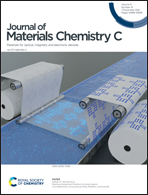Carbon fabric-based self-powered magnetoelectric tactile sensors for soft robot's sensing with resistance to acidic/alkaline environments†
Abstract
Self-powered tactile sensors for soft robots require unconventional design for both their materials and structures to fit for the softness of robots, as well as resistance to harsh working surroundings (e.g., acid or alkali environment). However, they are often susceptible to structural fracture and environmental corrosion, which destroy sensing performances and provide technical challenges in the preparation of self-sensing soft robots. Here we firstly demonstrate carbon fabric-based magnetoelectric tactile sensor (C-METS) consisting of flexible carbon cloths and magnetic elastomers. Compared with the traditional sensor using copper wires as the conductive part, C-METS exhibits good softness and resistance to harsh acid/alkali environments. Owing to the use of carbon fabric, C-METS can be pressed and then recovered after 10 000 cycles, indicating along-term durability. The working mechanism of magnetoelectric induction has been verified by experimental results and Maxwell numerical simulation. In addition, two C-METS with opposite magnetic fields are assembled in the front and back parts of a soft robot, endowing the robot with multi-directional sensing capability. We expect that C-METS can provide a novel avenue for carbon fabric as conductive materials in the development of flexible and stable magnetoelectric sensors.



 Please wait while we load your content...
Please wait while we load your content...